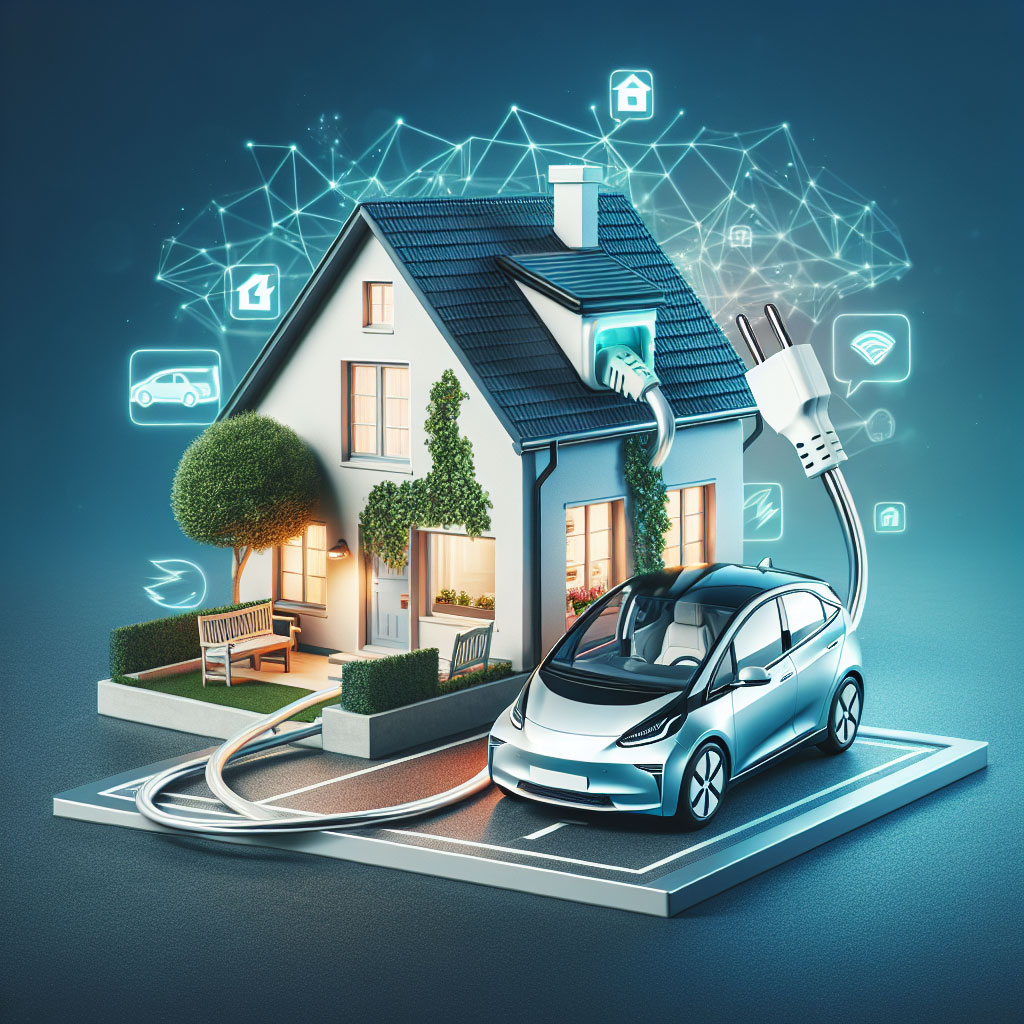
Vehicle-to-home (V2H) charging is emerging as a practical way for Australian households to use electric vehicles (EVs) as a home-power resource – providing backup electricity during outages, supporting peak-cost management and, in time, participating in broader grid services. While most home chargers and EVs in Australia today are configured for one-way charging, V2H and other bidirectional technologies are gaining traction, driven by improving standards, pilot programs and growing consumer interest in home energy resilience.
How V2H works – the components and process
- V2H-enabled vehicle: The EV must support bidirectional charging. Some vehicles provide vehicle-to-load (V2L) capability – a low-power AC output for appliances – but true V2H requires an EV that can export power back to the home under coordinated control.
- Bidirectional charger / inverter: A specialised charger or inverter converts DC battery power to AC for household use and manages power flow both into and out of the vehicle. These devices perform the same role as home battery inverters but work with an EV battery.
- Home energy management and safety systems: An integrated energy management system (EMS) or smart inverter coordinates solar PV (if present), household loads and the EV to decide when to export or import. For safety, an automatic transfer switch (ATS) or an isolation device isolates the home from the grid during V2H operation to prevent back-feeding the distribution network during outages.
Why Australians are paying attention
- Resilience: V2H offers a readily available, mobile energy store for blackouts – particularly attractive for regional and bushfire-prone areas.
- Cost management: Paired with time-of-use tariffs or rooftop solar, V2H can shift energy use from expensive peak periods to cheaper off-peak windows or stored solar, reducing household bills.
- Grid benefits: In future, aggregated V2H/vehicle-to-grid (V2G) resources could support grid stability and frequency services, though large-scale market participation remains largely at the pilot and trial stage in Australia.
Current state of the market and compatibility
- Vehicle support: A limited but growing number of EV models worldwide support bidirectional charging or V2L features. In Australia, some recent EVs offer V2L for small appliance use; full V2H/V2G capability varies by model and often depends on local certification and software. Tesla currently does not broadly support V2G/V2H as an officially enabled feature in most markets.
- Chargers and standards: Bidirectional AC charging typically operates at single-phase household voltages and delivers between roughly 2-7 kW, depending on the vehicle and charger. DC bidirectional systems can provide higher power but are still emerging in domestic settings. Industry moves toward standards such as ISO 15118 are important enablers for plug-and-charge and bidirectional interoperability, but local certification and integration remain necessary.
- Regulatory and grid considerations: Export limits, connection approvals and safety rules mean households planning V2H must consult their distributor and comply with local regulations. Australian network operators are increasingly engaging with trials but formal, large-scale market participation for V2G remains constrained by regulatory frameworks and metering/settlement arrangements.
How V2H differs from standard home charging
- One-way (standard) charging:
- Level 1 (standard outlet): Slow AC charging on a normal power point, typically adding around 8-12 km of range per hour. Practical for short daily commutes and overnight charging, but subject to circuit capacity and safety considerations.
- Level 2 (dedicated home charger): A wall-mounted AC charger installed on a dedicated circuit. Faster than Level 1 and commonly used in Australian homes; typically capable of fully charging most EVs overnight.
- Two-way (V2H) charging:
- Requires bidirectional hardware and software and an integrated EMS.
- Allows power flow from EV battery to house (and potentially back to the grid when V2G is enabled).
- Needs additional safety features – transfer switches and isolation devices – and often network approval.
Practical considerations for Australian households
- Electrical supply and capacity: Most homes in Australia are single-phase. V2H systems are commonly designed to operate within single-phase limits (2-7 kW). Heavier commercial or fast-charging use may require three-phase supply or significant upgrades to the property’s electrical infrastructure.
- Installation costs: Installing a standard Level 2 charger typically ranges from around A$1,200 to A$4,000, depending on the site, cabling and switchboard condition. Bidirectional systems add further cost: specialised inverters/chargers, transfer equipment and integration can add several thousand dollars – often bringing total V2H-ready installations into the mid-to-high thousands. Prices vary considerably with hardware choices, installer rates and any required switchboard or supply upgrades.
- Safety, compliance and approvals: Use a licensed electrician with EV charger experience. You’ll need appropriate RCDs, a dedicated circuit and often a switchboard assessment. If you plan to export to the grid or switch to islanded operation during an outage, your distributor will typically require documentation and may set export limits.
- Vehicle warranty and battery wear: Manufacturers have different positions on bidirectional use. Some EV makers provide guidance that controlled bidirectional use has limited impact if managed by smart software; others are more conservative. Check warranty terms before enabling V2H/V2G functions.
- Integration with solar and home batteries: V2H works best when coordinated with rooftop solar and an EMS. This enables charging the car from cheaper or renewable sources and discharging during peak price periods or outages. Effective management software is essential for optimising savings and preserving battery health.
Use cases and limits
- Backup power during outages: V2H can supply essential loads (fridge, lighting, medical equipment) for hours depending on EV battery size and load. Properly installed ATS and a critical loads panel are important to prioritise essential circuits.
- Peak shaving and cost reduction: Use stored energy to reduce demand peak charges or shift consumption away from expensive periods. Savings depend on tariff structure, battery capacity and charging behaviour.
- Grid services and revenue: In some jurisdictions and trials, EVs have been aggregated to provide frequency response or demand management services. In Australia, commercial-scale participation is still limited and largely conducted as research or pilot programs.
- Mobility trade-offs: Using an EV battery for home power reduces available driving range until recharged. Owners who rely on maximum daily driving range should consider whether V2H suits their routine.
How to prepare if you’re interested in V2H
- Check vehicle compatibility: Confirm with your dealer or manufacturer whether your EV supports bidirectional charging or V2L and under what conditions.
- Assess your home’s electrical capacity: Have a licensed electrician evaluate your switchboard, meter and supply – and quote any upgrades or safety equipment required.
- Discuss warranties and serviceability: Ask the vehicle manufacturer whether bidirectional use affects warranty and what software/configuration is recommended.
- Explore rebates and incentives: State and territory programs occasionally offer incentives for EV charging infrastructure or home batteries – check current federal and local offerings.
- Get multiple quotes: Bidirectional systems are complex. Seek several installers experienced in EV integration and solar/battery systems.
- Plan for software and monitoring: Choose an EMS or charger platform that supports scheduling, solar prioritisation and safety features.
Conclusion
V2H in Australia represents a compelling next step in domestic energy management, offering resilience and potential cost benefits to EV owners. While one-way home charging remains the norm today, bidirectional charging is moving from pilots to commercial offerings as standards mature and more EVs gain compatibility. However, uptake requires careful planning: vehicle and charger compatibility, safety systems, potential switchboard upgrades and regulatory approvals all matter. For many households, starting with a smart Level 2 charger and solar integration is a practical first step; for those seeking greater resilience, a V2H-capable solution can make sense – provided you work with accredited installers and confirm warranty and grid-export conditions.
FAQs
What is the difference between V2H and V2G?
V2H (vehicle-to-home) supplies a house with power from an EV battery; V2G (vehicle-to-grid) exports power back to the wider electricity network to provide grid services. V2H is primarily about household resilience and bill management; V2G focuses on aggregated grid benefits and market participation.
Which EVs in Australia currently support V2H?
Support varies by model and manufacturer. Some vehicles offer V2L (a low-power AC outlet) and a limited set have bidirectional capabilities internationally. Check your vehicle’s specifications and contact the manufacturer or dealer for up-to-date compatibility and local enablement.
How much power can V2H provide to my home?
Typical single-phase V2H installations deliver between about 2 kW and 7 kW, enough to power essential appliances or reduce peak household loads. DC bidirectional systems can be larger but are not yet common in domestic settings.
Will using V2H void my EV warranty?
Not necessarily, but it depends on the manufacturer’s terms. Some manufacturers allow controlled bidirectional use; others restrict or do not support it. Always confirm with the vehicle maker before enabling V2H.
How much does it cost to install a V2H system?
A standard Level 2 charger installation commonly ranges from roughly A$1,200 to A$4,000. A full V2H-capable setup – including a bidirectional inverter/charger, transfer switch and integration work – can add several thousand dollars on top of that. Costs vary with hardware, installer rates and any required electrical upgrades.
About EV Evolution
EV Evolution is the leading online platform dedicated to Australian electric vehicle owners and enthusiasts. We foster a vibrant community, delivering essential EV news and insights, and enhancing user engagement through our innovative, AI-powered chatbot for dynamic discussions. Our mission is to empower Australian electric vehicle owners and enthusiasts by fostering a vibrant, AI-driven online community that connects, informs, and advances the nation’s electric vehicle landscape.




